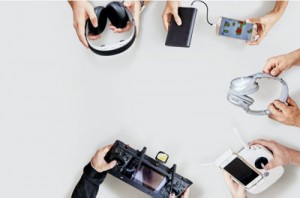New gadgets and tech of 2016
View(s): (Courtesy Popular Mechanics) - Consider 2016 the year that brilliant innovations attacked all our technological annoyances. It was the year of home Wi-Fi that just works. Phones designed to survive a night out. The year we said to hell with tangled earbuds and found a video headset we’d actually wear. But that’s just the everyday stuff. It was also the year drones got small and smart. The year the fastest zero-to-60 time belonged to an electric vehicle. Seriously? Behold the hardware and software that exemplified the notion that, in ways subtle and grand, technology makes our lives better.
(Courtesy Popular Mechanics) - Consider 2016 the year that brilliant innovations attacked all our technological annoyances. It was the year of home Wi-Fi that just works. Phones designed to survive a night out. The year we said to hell with tangled earbuds and found a video headset we’d actually wear. But that’s just the everyday stuff. It was also the year drones got small and smart. The year the fastest zero-to-60 time belonged to an electric vehicle. Seriously? Behold the hardware and software that exemplified the notion that, in ways subtle and grand, technology makes our lives better.
Headphones perfected
Wireless earbuds were inevitable, but for years all we got were flawed prototypes and dicey crowdfunding campaigns. Now they’re finally available in versions we can embrace: The battery lasts for a typical commute. Fit them with the correct foam tips and they stay put even while running. Most importantly, with Bluetooth’s quiet improvements, the transmitters and software in our favourite pairs, the Earins and Erato Apollo 7s, get more data from phone to earbud, meaning low latency, quick pairing, and sound quality indistinguishable from wired earbuds. We like that the Earins automatically pair when you take them out of the case, but we’ll give the Apollo 7s the overall edge for being waterproof and having a transmitter in each ear, which makes it wonderfully difficult to drop the signal. But either option will make the days of untangling cords every time you want music seem downright archaic. We can’t go back.
Not-stupid drones
 We’ll look back at the DJI Phantom 4 and the Yuneec Typhoon H as the models that despecialised the drone. Both can follow subjects without your help, steadily tracking a human, car, or animal to Michael Bay–like cinematic effect. Both also have object-avoidance sensors. Add that up and you get automated flight without fear of crashing. It’s uncanny when it works: Tracking a toddler full-steam-ahead toward a tree trunk, the Phantom 4 halts, hovering until steered to safety. No, unless you’ve got 100,000-plus, you don’t need to spend four figures on a drone. But if you do it anyway, you can finally be confident it’ll be worth it.
We’ll look back at the DJI Phantom 4 and the Yuneec Typhoon H as the models that despecialised the drone. Both can follow subjects without your help, steadily tracking a human, car, or animal to Michael Bay–like cinematic effect. Both also have object-avoidance sensors. Add that up and you get automated flight without fear of crashing. It’s uncanny when it works: Tracking a toddler full-steam-ahead toward a tree trunk, the Phantom 4 halts, hovering until steered to safety. No, unless you’ve got 100,000-plus, you don’t need to spend four figures on a drone. But if you do it anyway, you can finally be confident it’ll be worth it.
Artificial intelligence earns its keep
In 2015, venture capitalists were all talking about financial-technology apps, which distill investment decisions to a few taps, then remove the decision part. This year those apps matured and proliferated, making investors out of people who couldn’t define “mutual funds” or “stocks.” Acorns is the best example. It links to your bank account and debit or credit cards, and whenever you spend money, rounds up and stashes the difference in an investment. So if a latte costs $5.34, Acorns pockets a negligible $0.66. Once it’s collected at least $5, it invests the money based on the level of risk you choose. If you’d prefer no risk at all, Digit is a great alternative. It collects small amounts of money based on your spending habits and puts them in an FDIC-insured savings account you can access whenever you like. The drawback: The money earns negligible interest.
Bose goes wireless
Noise-cancelling is when headphones use one sound frequency to cancel out another that would otherwise interrupt the listening experience. In the years since Bose invented the technology, its patents and constant research have meant that no other brand can match it for tuning out combustion engines and HVAC systems. But until this year, Bose has never gone wireless. So at less than 10 ounces and wire-free, its QC35 over-ears are revelatory.
Avegant Glyph
The Glyph might be the best portable screen around for movies or gaming-except it’s not a screen. Inside the band of the headset-worn parallel to the ground, in front of your eyes-low-powered LEDs shine into an array of millions of mirrors that project images straight onto your retinas. The result is a huge, sharp picture; a personal, portable cinema for one that shows just about anything you can plug into with an HDMI cable. Because the Glyph’s visual system mimics the way light reflects off objects in the screen-less vision of everyday life, your eyes don’t fatigue. And you can use it anywhere: On a plane, catch a movie on the big screen.
Walabot
A stud finder with superpowers: Hold it against drywall and the Walabot’s radiowave-sensing system detects the shape and depth of materials in its path with enough accuracy to actually know what they are. Then the visuals – every stud, pipe, and rodent within four inches of the surface – feed straight to your smartphone. It can’t see through metal, but the technology is good enough that Walabot’s parent company, Vayyar, is further developing it to detect cancerous growths beneath human skin.Resilient Wi-Fi
In big houses filled with iPhones and Rokus, standard wireless routers are woefully inadequate, unable to distribute a strong signal between devices or into far-off rooms. Mesh Wi-Fi is the fix: multiple small routers around the house function as repeaters, sending data upstairs and around corners, blanketing the living space with Internet. Since it only works if each unit is in a conspicuous place, companies like eero, Plume, and AmpliFi (above) sheath their hardware in beautiful, futuristic shells. It’s an investment compared to your current router-at least $200 to get started-but think of it as a way to get your money’s worth from your Internet bill.


